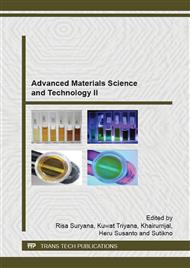p.88
p.92
p.96
p.100
p.104
p.109
p.114
p.119
p.123
Texture Analysis of the Hot Rolling Austenitic Cr-Ni Steel Using Neutron Diffraction Method
Abstract:
Synthesis of austenite stainless steel using extracted minerals from Indonesian mines has been carried out. It is namely A2 steel. The main raw material of making non standard steel A2 is granular scrap iron, nickel, iron-chromium, iron-manganese, and iron-silicon. It is obtained from non standards. A component of A2 steel consists of 15,42%Cr, 25,01%Ni, 0,32%Mn, 0,96%Si and 0,34%C with impurities of 0,039%V and 0,051%Cu. Characterization using neutron diffraction technique shows the first four Bragg peaks of (111), (200), (220) and (311). A machining process was performed to make a plat from ingot. After the machining process, intensities and FWHM of the first two Bragg peaks of (111) and (200) are quite the same. But the intensity of the peaks (220) and (311) changes. It is calculated that for (220)peak the decreasing intensity about 51.6% and increasing FWHM about 0.14%, whereas for (311) peak the intensity increase about 40.2% and the FWHM decrease about 3%. Furthermore, the material obtained from the machining process is used as a reference to the condition of the material without rolling. After being subjected to rolling up to 70% thickness reduction, crystal orientation changes from highest intensity with a sequence of (200), (111) and (220) to (220) (111) and (200) with highest increasing intensity about 2.25 times at (220). Quantitative analysis of texture after the rolling process is shown in pole figures of (111), (200) and (220). It is characterized that crystals are oriented mainly to {110} <113>, texture index is 1.0671.
Info:
Periodical:
Pages:
104-108
Citation:
Online since:
August 2015
Authors:
Keywords:
Price:
Сopyright:
© 2015 Trans Tech Publications Ltd. All Rights Reserved
Share:
Citation:


